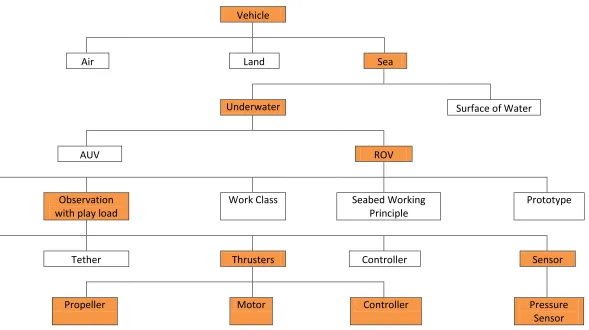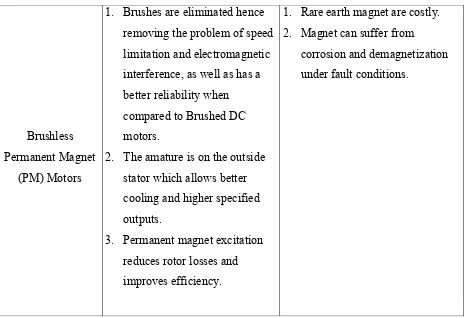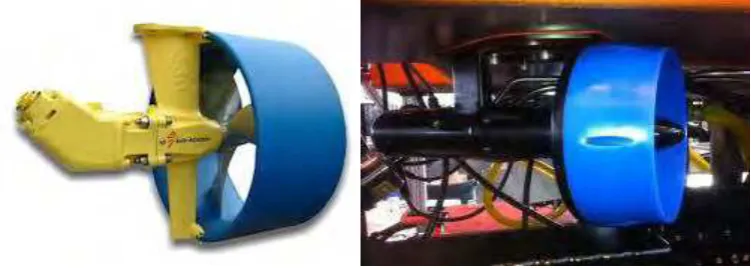FACULTY OF ELECTRICAL ENGINEERING UNIVERSITI TEKNIKAL MALAYSIA MELAKA
FINAL YEAR PROJECT REPORT BEKU 4894
DESIGN THE AUTO DEPTH CONTROL FOR UNMANNED
UNDERWATER VEHICLE CONTROL USING THRUSTER SYSTEM
Ismail Bin Jaaffar
“I hereby declare that I have read through this report entitle “Design the auto depth control for unmanned underwater vehicle control using thruster system” and found that it has comply the partial fulfilment for awarding the degree of Bachelor of Mechatronic Engineering”.
Signature : ...
Supervisors Name : ...
DESIGN THE AUTO DEPTH CONTROL FOR UNMANNED UNDERWATER VEHICLE CONTROL USING THRUSTER SYSTEM
ISMAIL BIN JAAFFAR
A report submitted in partial fulfillment of the requirements for the degree of Bachelor of Mechatronic Engineering
Faculty of Electrical Engineering
UNIVERSITI TEKNIKAL MALAYSIA MELAKA
I declare that this report entitle “Design the auto depth control for unmanned underwater vehicle control using thruster system” is the result of my own research except as cited in the references. The report has not been accepted for any degree and is not concurrently submitted in candidature of any other degree.
Signature : ... Name : ISMAIL BIN JAAFFAR
ACKNOWLEDGEMENT
I would like to express my deepest appreciation to all those who provided me the possibility to complete this report. A special gratitude I give to my final year project coordinator, Dr. Mariam Binti Md Ghazaly whose contribution in stimulating suggestions and encouragement helped me to coordinate my project especially in writing this report.
ABSTRACT
ABSTRAK
TABLE OF CONTENTS
CHAPTER TITLE PAGE
ACKNOLEDGEMENT i
ABSTRACT ii
TABLE OF CONTENT iv
LIST OF TABLE v
LIST OF FIGURE vi
LIST OF ABBREVIATION vii
LIST OF APPENDICES viii
1 INTRODUCTION 1
2 LITERATURE REVIEW 5
2.1 MOTOR 5
2.2 PROPELLER 9
2.3 SENSOR 12
2.3.1 PRESSURE SENSOR 13
3 METHODOLOGY 17
3.1 PROCESS FLOW CHART 17
3.2 SYSTEM OVERVIEW 20
3.3 COMPONENT 20
3.3.1 MICROCONTROLLER 20
3.3.2 SK40C 21
3.3.3 RELAY 21
3.3.4 VOLTAGE REGULATOR 22
CHAPTER TITLE PAGE
3.3.6 THRUSTER 23
3.4 SOFTWARE 24
3.5 SYSTEM FLOW 25
3.6 EXPERIMENTAL SET UP 27
3.6.1 EXPERIMENT 1 28
3.6.2 EXPERIMENT 2 29
3.6.3 EXPERIMENT 3 31
3.6.4 EXPERIMENT 4 32
3.6.5 EXPERIMENT 5 33
4 RESULT AND ANALYSIS 34
4.1 SENSOR TESTING RESULT 34
4.2 THRUSTER PERFOMANCE TEST RESULT 36
4.3 ACCURACY TEST RESULT 37
4.4 STABILITY TEST RESULT 38
4.5 WATERPROOF TEST RESULT 39
4.6 PROBLEM OCCURS DURING THIS PROJECT 41
5 CONCLUSION AND RECOMMENDATION 42
REFFERENCES 43
LIST OF TABLES
TABLE TITLE PAGE
Table 2.1: Table showing the comparison of various motor technologies 5
Table 2.2: Type of analogue pressure sensor 13
Table 2.3: Comparison between piezoresistive strain gauge and capacitive
LIST OF FIGURE
FIGURE TITLE PAGE
Figure 1.1 The Underwater Research using ROV [4] 2
Figure 2.1 Hydraulic Thrusters 8
Figure 2.2 Example of propeller with different size [19] 9
Figure 2.3 Pitching angle of the propeller [19] 9
Figure 2.4 Propellers with different number of blade [19] 10
Figure 2.5 Angle Of Attack Diagram for Propeller Blade 11
Figure 2.6 Analogue sensor output 12
Figure 3.1 Project Flow Chart 17
Figure 3.2 Project Flow Chart 18
Figure 3.3 System Overview 20
Figure 3.4 PIC16F877A 20
Figure 3.5 Relay 22
Figure3.6 Schematic diagram of 5V voltage regulator 22
Figure 3.7 Circuit Diagram of the pressure sensor for MPX4250GP and
MPX5700GP 23
Figure 3.8 Thruster 23
Figure 3.10 Thruster circuit simulations 24
Figure 3.11 The control board and the thruster 25
Figure 3.12 Testing pool 26
Figure 3.13 Sensor testing set up 27
Figure 3.14 Equipmental setup 28
Figure 3.15 Accuracy test set up 29
Figure 3.16 Back view of the ROV 31
Figure 3.17 The direction of disturbance 32
Figure 4.1 Graph voltage against pressure 34
Figure 4.2 Graph time against no of experiment 36
Figure 4.3 Accuracy test result 37
Figure 4.5 Graph weight against no of test 39
Figure 4.6 The weight scale 40
LIST OF SYMBOLS
R - Propeller Radius, m. T - Thrust Force, Newton. Q - Propeller Torque, Nm
ωm - Motor Rotational Rate, rad/sec. N - Reduction Gear Ratio.
Lift - Lift Force, N. Drag - Drag Force, N.
A - Tunnel Cross Sectional Area � - Angle of Inlet to Blades, rad. a, - Effective Angle of Attack, rad. p - Blade Pitch, rad.
� - Section Average Flow Velocity, m/s.
- Propeler Velocity,m/ s.
LIST OF APPENDICES
APPENDICES TITLE PAGE
A Package dimension 41
B MPX4250GP and MPX5700GP data sheet graph 42
C Experiment 1 43
D Experiment 2 44
E Experiment 3 45
F Experiment 4 46
G Experiment 5 47
CHAPTER 1
INTRODUCTION
1.1 Project Background
Remotely Operated Vehicle (ROV) is an underwater robot that designed on purpose for surveillance, monitoring and collecting data for all underwater activities. It is a widely safe use mechanism type for underwater vehicle serve mostly military, commercial, and scientist needs. The main purpose of the invention of this robot is to do the operation that hazardous to human being or at a depth which has high pressure that could affect the system of human body. The majority of ROV’s in services are used by the oil industry for maintaining oil rigs and pipelines [17].
Nowadays, discovery of underwater world become more popular among scientists and engineers. New technological devices that can submerge into the deep oceans in order discover more about the underwater world are invented day by day. ROV is a very common vehicle for underwater researcher to help them in investigating the underwater species of animal and plant at the bottom of the ocean that normally human can’t do. It emphasizes the difficulty of working to conduct these operations at such extreme depths, where humans can’t directly interact with the malfunctioning equipment [1].
In the mean time, the ROV are already developed with thrusters in order to make the robot to move upward, downward, forward, reverse, right and left. However, not all of the ROV installed with the auto depth control system using thrusters or ballast tank. The auto control system is built for maintaining the ROV at specified depth for a long time.
The system indirectly helps the researcher to record a video and take a sample at certain depth of the sea as shown in Figure 1.1. This system is also has been applied in oil and gas industries, where this auto depth control systems is used to help the underwater maintenance at the offshore. The ROV needs to maintain at certain depth to do the inspecting or monitoring job on the piping or chain.
1.3 Problem Statement
A ROV that named as UTeM Underwater Research Group ROV (UTeRG-ROV) was invented in 2012. However the previous ROV do not have auto depth control system. The ROV is loaded with thrusters which controlling upward, forward and reverse movement of the ROV. Without the auto depth control, the ROV cannot stay at current depth and it hard for the researcher to take out any data at a specified depth. Hence, an enhancement of previous ROV in term of depth control is needed.
Therefore, the auto depth control for ROV using thruster system is proposed. The auto depth control of the ROV is designed to assist the ROV in maintaining the specified depth using thruster system.
1.4 OBJECTIVES
The objectives of this project are:
1. To design the auto depth control using thrusters system
2. To analyze the sensitivity of the chosen pressure sensor and validate the results obtained.
1.5 SCOPES AND LIMITATION
The scopes and limitation of this project are:
1. The project only focuses on auto depth control system using pressure depth sensor by completing the existed ROV prototype.
2. Two thruster are used to submerge the ROV. 3. The selected pitch is 450.
Vehicle
Air Land Sea
Underwater Surface of Water
AUV ROV
Pure Observation Observation
with play load
Work Class Seabed Working
Principle
Prototype
Material Tether Thrusters Controller Sensor
Propeller Motor Controller Pressure
Sensor
CHAPTER 2
LITERATURE REVIEW
This chapter discuss on the general information of the auto depth system which will be used for UTeRG-ROV. The type of motor use and the selection of propellers in which size, diameter, number of blade and blade pitch to the centre are included in this study as well as pressure sensor. The facts and information are collected from reliable source and elaborated based on the understanding of the review. The previous research information, methodologies and design are used as references and guidelines for this project.
2.1 Motor
Motor is a machine which converts electric energy into mechanical energy. The electric motor is one of the prime mover type for a mechanical system. Motor come in various shapes, sizes, and technologies, each designed has its own functionality. As information, the most common thrusters’ motor on ROV systems is selected due to its power, availability, variety, reliability, and ease of interfaces. Motor is a one part in thrusters that influenced the thrusters’ performance. The motor drive its shaft to move the propeller hence the thrusters. There is several type of motor that commonly use in ROV thrusters. The motor is selected due its ability to give out the higher torque and speed. The low power consumption also must be considered in motor selection.
Table 2.1: Comparison of various motor technologies
Motor Type Advantages Disadvantage
Variable Reluctance Permenant Magnet
1. High specified tourque. 1. Suffer from high axial flux losses.
Brushed DC Motors
2. Simple control. 2. Wear on brushes make reliability an issue.
3. Due to brushes there are also interference noises.
Induction Motors
1. Robust and inexpensive. 2. Technologies is well
understood.
1. Motor size tends to be large for this application.
2. Control is complex and expensive.
Switched Reluctance Motors
1. Construction is robust and simple.
2. Bulk of losses appear on stator which is easy to cool.
3. Torque is independent of polarity of phase current which allows the reduction of
semiconductor switches in the controller in certain
applications.
4. Torque-speed characteristics can be tailored more easily compared to induction motors or permanent magnet motors.
1. Has inherent high torque ripple that causes vibration and noise. 2. High peak currents and high
controller chopping frequency that cause electromagnetic interference.
3. Higher controller switching frequency also cause high core loses and the motor require a more expensive grade of steel.
Hydraulic Motors
1. High specified torque. 1. Many mechanical parts makes reliability an issue.
Table 2.1 shows the comparison of various motor topologies that could be used as a drive for the thrusters systems. Conventional thrusters for work class underwater ROV are driven by hydraulic motors as shown in Figure 2.1. They are normally used because hydraulic motors are able to produce a higher specific torque when compared to traditional electric motors (such as induction motors). This would mean that if traditional electric motors were used to drive thrusters for ROVs, they would result in a much larger electric thruster unit. This is undesirable, as a larger electric motor would impede the flow of water through the propeller, as well as increase the overall space required on the vehicle to accommodate the thruster unit and increases the overall weight of the vehicle. Hydraulic thruster systems tend to be significantly less reliable compared to their electric counterparts[6]. This is due to the many mechanical parts in a hydraulic thruster system that tend to wear with time, with broken seals and water leakage into the system being amongst some of the common faults. A hydraulic system breakdown can be very costly because it takes a long time to repair. A typical system breakdown would involve replacing the broken part, followed by flushing the hydraulic system and refilling it with oil, priming and testing the system. This is a process that can take 7 to 10 hours, and operational costs such as the ROV operator and the ROV support vessel are still being paid during this time.
Brushless Permanent Magnet
(PM) Motors
1. Brushes are eliminated hence removing the problem of speed limitation and electromagnetic interference, as well as has a better reliability when compared to Brushed DC motors.
2. The amature is on the outside stator which allows better cooling and higher specified outputs.
3. Permanent magnet excitation reduces rotor losses and improves efficiency.
1. Rare earth magnet are costly. 2. Magnet can suffer from
Figure 2.1: Hydraulic Thrusters
In addition, hydraulic thruster systems are inefficient. Most hydraulic thruster systems have efficiencies less than 53% [5], which is very low compared to possible efficiencies that may be achieved by all electric thruster system of 80 to 85% system efficiency. This efficiency improvement has implications on other components of an ROV system such as the reduction in size of the transformer, switchgear, and umbilical, due to the required power transmitted for the job.
Advances made in permanent magnet material and alternative electric motor topologies have made the use of all-electric thruster systems feasible. Electric motors can now be designed to have similar efficiencies and torque outputs for a much smaller size compared to traditional electric motors, albeit at a significant increase of cost if expensive rare earth magnets are used. There are many advantages of using an electric thruster systems. Electric motors used for thruster systems have a linear response of torque to control signal when compared to hydraulic motors that have dead bands at low velocities. This is an important feature for ROV tasks that require better positioning and accurate repeatability of motion, such as tasks like repair, maintenance and construction [7].
2.2 Propeller
The momentum theory of propellers was originally found by Rankine and Froude shows that for a propeller actuator disc, thrust can be expected to depend on the square of the flow velocity through the blading and that the energy efficiency of the propeller is increased when the thrust loading on the blade is reduced [13]. This theory does not explain deeper on how the shape of the propeller blade is related to the thrust of the ROV. The theory of aerodynamic is closely related to the blade element theories, in which the lift and drag forces generated from any element of the blade's cross section are added over the total length of the blade [15]. The local angle attack at blade section is related to the lift and drag forces. A representation of lift and drag coefficients as a function of effective angle of attack is then required to complete the calculation of the amount of thrust and torque. Lift and drag coefficients available for many different parts of the wing for small angles [19].
Figure 2.2: Example of propeller with different size [19]
Figure 2.3: Pitching angle of the propeller [19]
350 400 450 500
45mm m
Figure 2.4: Propellers with different number of blade [19]
Gear reduction which directly connect the fan motor, and to a certain blade, tangential speed measured at a few simple radial position (usually taken at 0.7R), is such that the velocity of the fluid relative to the blade is given by,
= 0.7 �
� (2.1)
Now, depending on the velocity of the incoming fluid particles relative to the propeller blading, �, an inlet effective angle of attack is established, modelled by the
variable, as in Figure 2.5 where:
� = 2− −arctan � (2.2)
The total relative velocity squared magnitude is then
2 = 2 +
�2 (2.3)
![Figure 1.1: The Underwater Research using ROV [4]](https://thumb-ap.123doks.com/thumbv2/123dok/536672.62348/16.595.193.416.481.671/figure-underwater-research-using-rov.webp)




![Figure 2.2: Example of propeller with different size [19]](https://thumb-ap.123doks.com/thumbv2/123dok/536672.62348/23.595.91.524.573.710/figure-example-propeller-different-size.webp)
![Figure 2.4: Propellers with different number of blade [19]](https://thumb-ap.123doks.com/thumbv2/123dok/536672.62348/24.595.107.508.72.222/figure-propellers-different-number-blade.webp)